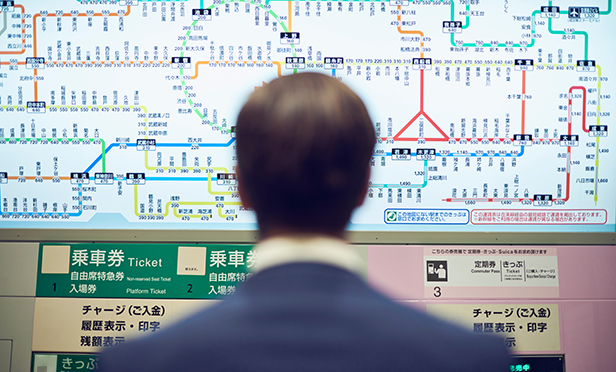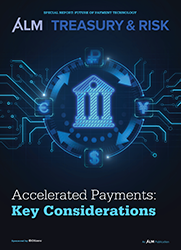
The question of how payment technologies will evolve in the next few years triggers innovative thinking and an inspired analogy: "As we add real-time and blockchain networks to the mix of incumbent card and bank rails, money-movement options are starting to look like the Tokyo Metro map," says Ernst & Young LLP partner/principal and Americas payments strategy and M&A leader Sara Elinson. In other words, the payments landscape will soon resemble a complex web of travel options that alternately intersect, overlap, and run parallel to one another.
These are exciting, yet confusing, times for corporate treasury functions seeking to navigate new advancements in payments. Treasurers today need to try to get a read on which technologies are ripe for breakthroughs, then put in place mechanisms that will enable their organization to adopt emerging solutions with maximum speed and effectiveness.
For the first part of this process—determining how payment offerings are likely to evolve in the next two to three years—treasury leaders should consider which technologies are being implemented "faster than expected" today, suggests Strategic Treasurer managing partner Craig Jeffery. Two types of technologies that fit the bill, he notes, are application programming interfaces (APIs) and artificial intelligence (AI) and machine learning (ML).
"The build-out of APIs is speeding adoption, since the banks and tech firms have scale and the adoption process benefits from the network effect," continues Jeffery, referring to the idea that more users translates to more value for all participants. "AI/ML is similarly scaling quickly due to the network effect, but it has the added support of heavy concerns about escalating fraud and the need to use technology to defend against significant and sophisticated threats."
Global adoption of the ISO 20022 standard messaging format will have a similar enabling effect, notes Deloitte Consulting transaction banking practice leader Michelle Gauchat. She expects adoption of the new standard to foster more interconnectivity among platforms in different countries and regions. That will facilitate advancements which drive more—and more efficient—cross-border transactions. Cross-border payments mark an area where there remain "lots of opportunity to improve overall efficiency and introduce more speed to transaction processing," Gauchat adds.
Many types of breakthroughs will require improvements in specific aspects of payment technologies, Elinson notes, including orchestration layers, data-translation engines, and fraud and security tools—all of which are worth monitoring.
As they evaluate the ways in which payment technologies are evolving, treasury leaders should also be looking at what mechanisms they need to have in place to accelerate and streamline adoption of those solutions. Payments and treasury experts indicate that the following actions will prove helpful on that count:
- Focus on the future. In addition to delivering clear benefits to organizations that adopt them, new payment technologies may also introduce more complexity and, therefore, additional operational costs. "So, finance and treasury teams need to be thoughtful about their overall payments strategy," says Elinson, who advises treasury leaders to take stock of their future payments needs. "I'd be willing to bet there are no-regret moves you can make today that will be better for your bottom line, your customers, and your vendors."
- Partner with IT and treasury technology vendors. "It will be critical for treasury teams to work more closely with their IT counterparts and for IT teams to learn more about the technology needs of treasury teams," says Prashant Patri, a Deloitte Risk & Financial Advisory principal. "Organizations should also continue to engage with key treasury management system vendors to understand the latest investments and product roadmaps, especially those related to analytical capabilities, which is [currently] a major focus of investments."
- Differentiate. While relatively few longer-standing payment rails will be decommissioned anytime soon, treasury functions can manage their network of payment modalities together to improve process efficiency. Doing so will "translate to lower costs, less fraud, and better customer and colleague experience," according to Elinson. Gauchat encourages treasury teams to consider consolidating payment platforms into two general categories: low-value real-time payments (RTP) and high-value RTP.
As the universe of payment solutions grows more innovative and more complex, treasury functions will need to maintain their focus on identifying what options best meet their organization's current and future needs. "With accelerating complexity," Jeffery adds, "most organizations will need to continue to look to both technology and networks to provide simplicity."
See also:

- November 2022 Special Report
- Accelerated Payments: Key Considerations
- The Pros and Cons of New Digital Payment Options
- Next-Level Efficiency Opportunities for A/R and A/P
- Companies That Don't Modernize Payments Risk Being Left Behind
- The Future of Real-Time Global Payments
- Broad Benefits from Centralizing Global Treasury Operations
- High-Impact AI Use Cases for Treasury
- Payment System Integration via APIs
Eric Krell's work has appeared previously in Treasury & Risk, as well as Consulting Magazine. He is based in Austin, Texas.
© 2024 ALM Global, LLC, All Rights Reserved. Request academic re-use from www.copyright.com. All other uses, submit a request to [email protected]. For more information visit Asset & Logo Licensing.






